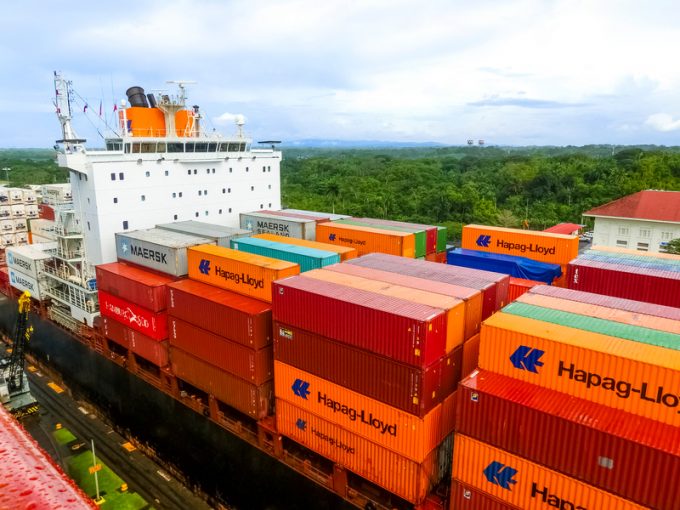Bolloré bounce boosts CMA CGM Q2 revenues, but job worries persist
CMA CGM Group has announced a “robust performance” in the second quarter, with revenues up ...
TFII: SOLID AS USUALMAERSK: WEAKENINGF: FALLING OFF A CLIFFAAPL: 'BOTTLENECK IN MAINLAND CHINA'AAPL: CHINA TRENDSDHL: GROWTH CAPEXR: ANOTHER SOLID DELIVERYMFT: HERE COMES THE FALLDSV: LOOK AT SCHENKER PERFORMANCEUPS: A WAVE OF DOWNGRADES DSV: BARGAIN BINKNX: EARNINGS OUTODFL: RISING AND FALLING AND THEN RISING
TFII: SOLID AS USUALMAERSK: WEAKENINGF: FALLING OFF A CLIFFAAPL: 'BOTTLENECK IN MAINLAND CHINA'AAPL: CHINA TRENDSDHL: GROWTH CAPEXR: ANOTHER SOLID DELIVERYMFT: HERE COMES THE FALLDSV: LOOK AT SCHENKER PERFORMANCEUPS: A WAVE OF DOWNGRADES DSV: BARGAIN BINKNX: EARNINGS OUTODFL: RISING AND FALLING AND THEN RISING

Hapag-Lloyd’s preliminary results for 2020, of an ebit of $1.5bn, are at the top end of its revised earnings forecast.
But the full effect of the surge in freight rates in the final months of 2019 will probably not be seen until this quarter.
Hapag-Lloyd said the main drivers for the enhanced results had been “improved freight rates and lower bunker prices”, as well as some $500m of cost savings.
The ebit figure included a one-off expense of around $140m in Q4 “mainly related to fleet optimisation”, which could be for scrubber installations on ships, as a well as the cost of a vessel being converted to run on LNG.
Liftings were down 200,000 teu on the previous year, to 11.8m teu, due to the impact of the pandemic on demand in the second quarter, but it bounced back strongly in the third, and fourth, when Hapag-Lloyd carried 100,000 teu more than the previous Q4, at 3.1m teu.
However, this figure may turn out to be below industry par, given that rival OOCL reported a 24% surge in liftings for the same period.
Despite the full-year volume decrease, Hapag-Lloyd’s revenue was up from $14.1bn in 2019 to $14.6bn, and for the fourth quarter turnover increased 17%on the same period of the previous year, to $4.1bn.
Average rates increased by 4% over the year, to $1,115 per teu, but were up 9.5% in fourth quarter to $1,163 per teu, relatively modest and perhaps surprising, given the huge spike in container spot rates which has seen the composite index of the Shanghai Containerized Freight Index (SCFI) treble in value.
Lars Jensen, of SeaIntelligence, said the average rate reported by the carrier illustrated that not all trades had seen big increases in rates.
“More importantly, it clearly shows that for Hapag-Lloyd a substantial amount of cargo must have been moving under contractual rates, agreed before the stellar increases,” he added.
Indeed, during the carrier’s Q3 results presentation in November, CEO Rolf Habben Jansen said “quite a lot” of contract cargo had been carried at 50% below the spot market level.
He explained that around a third of Hapag-Lloyd’s liftings consisted of annual contracts, another third from shorter-term contracts of three to six months, with the balance sourced from the spot market.
Shippers have told The Loadstar that some carriers had refused to honour contracts as spot rates skyrocketed and that they had been obliged to pay vastly inflated FAK rates and premium fees to secure shipment.
Moreover, where contracts have expired, or the MQC (minimum quantity commitment) number has been exceeded, carriers have declined to discuss new deals, preferring to ‘auction’ space to the highest bidders.
Notwithstanding the apparent loyalty of Hapag-Lloyd to fulfilling its contract obligations, there could be another reason for the carrier’s lower than expected average rate: David Kerstens, of investment banker Jefferies, told The Loadstar it was possible that it was due to the carrier’s method of accounting, which differs from most of its peers.
“Hapag-Lloyd uses end-of-voyage accounting, resulting in a delayed effect of 6-8 weeks before the accelerating volume and freight rates will become visible in results,” said Mr Kerstens.
Hapag-Lloyd’s audited 2020 results will be published on 18 March.
Comment on this article